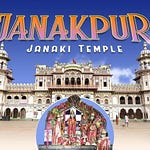Nestled at the foot of the Shivapuri Hills in northern Kathmandu, Budhanilkantha Temple is a mesmerizing spiritual site known for its massive reclining statue of Lord Vishnu, also revered as Mahavishnu. The temple, wrapped in legend, architecture, and spiritual sanctity, is one of the most revered Vaishnavite sites in Nepal and a focal point of devotion for thousands of Hindus every year.
📜 Origin and Foundation
The name Budhanilkantha derives from Sanskrit:
Budha = Old or Wise
Nilkantha = Blue-Throated (an epithet of Lord Shiva)
Despite the name's connotation with Shiva, the temple is dedicated to Vishnu. This duality adds to its mystical nature and has given rise to numerous local legends.
Foundation Era:
Historians trace the temple’s origins back to the Licchavi Dynasty, around the 7th to 8th century CE. It was likely commissioned during the reign of King Vishnugupta, a ruler devoted to Vishnu.
🏛 Architecture and Sculptural Marvel
At the heart of the temple lies a massive black basalt statue of Lord Vishnu reclining on the coils of the cosmic serpent Shesha Nāga. This magnificent piece:
Measures 5 meters (16.4 feet) in length.
Rests in a 13-meter-long pond symbolizing the Kshira Sagara or Ocean of Milk.
Features eleven hoods of Shesha Naga forming a protective umbrella around Vishnu’s head.
Shows Vishnu holding chakra (discus), shankha (conch), gada (mace), and padma (lotus) in his four arms.
The entire statue is believed to have been carved from a single piece of black stone, making it one of the most impressive examples of ancient Nepali stone craftsmanship.
🧿 Mystical Beliefs and Legends
The Floating Statue Mystery:
The statue gives the illusion of floating in water, though it rests on a submerged base. This visual phenomenon continues to puzzle scholars and devotees alike.
The Royal Prophecy:
A long-standing legend warns that if a Nepali monarch visits Budhanilkantha, he will die prematurely. Due to this prophecy, kings of Nepal traditionally avoided visiting the temple—reinforcing its enigmatic status.
Hidden Twin Theory:
Local folklore suggests that a twin statue lies beneath the surface, unseen for centuries, further heightening the site’s mystical aura.
📖 Historical Timeline
EraEvent7th-8th CenturyStatue and temple believed to be built during the Licchavi Dynasty.Malla PeriodBudhanilkantha became a sacred site for both Hindus and Buddhists.Modern EraMajor site for pilgrimages and Vaishnavite festivals; global recognition increases.
🪔 Daily Puja, Rituals, and Aarti
🕉 Ritual Practices
The temple follows traditional Vaishnavite rituals:
Abhishekam (Holy Bathing) with water, milk, and honey.
Shankha (Conch blowing) during morning and evening rituals.
Offerings of tulsi leaves, rice, fruits, incense, and oil lamps.
Continuous chanting of Vishnu Sahasranama and Bhagavad Gita verses.
✨ Aarti Timings
Morning Aarti: 5:00 AM – 6:30 AM
Evening Aarti: 6:00 PM – 7:30 PM
Special Pujas: Conducted during Ekadashi, Kartik month, and Haribodhini Ekadashi.
Devotees are welcome to attend these aartis, which are performed with deep reverence, drumbeats, and conch shell echoes, creating an ethereal spiritual ambiance.
🌌 Spiritual and Religious Importance
Budhanilkantha is not just an architectural gem but a symbol of cosmic balance and divine rest:
Vishnu’s reclining posture represents preservation of the universe in a state of balance.
The coiled Shesha Naga signifies eternity and cosmic energy.
Water around the statue symbolizes the primordial ocean, from which all creation emerges.
The temple holds immense value in Vaishnavism, often compared to Tirumala (India) and Muktinath (Nepal).
For many, just a darshan (glimpse) of the sleeping Vishnu is believed to wash away sins, fulfill desires, and bring inner peace.
📅 Major Festivals Celebrated
Haribodhini Ekadashi
Marks the end of Vishnu’s cosmic slumber.
Thousands of devotees offer prayers and circumambulate the temple.
Celebrated in the Kartik month (October–November).
Vishnu Jayanti
Celebrates the appearance of Lord Vishnu on earth.
Special abhishekas, bhajans, and free prasad (holy food) distributed.
🧭 Travel and Visiting Information
🧳 How to Reach
From Kathmandu City Center: ~10 km
Nearest Airport: Tribhuvan International Airport, Kathmandu (~12 km)
Transport: Public buses, taxis, and ride-shares are easily available.
🕘 Visiting Hours
Open Daily: 4:00 AM to 9:00 PM
Entry Fee: Free for all; donations are voluntary.
Best Time to Visit: Early morning or evening during aarti; ideal months are October to March.
👞 Visitor Tips
Footwear must be removed before entering.
Photography is permitted, but be respectful during rituals.
Maintain silence during prayers and circumambulation.
Women often offer red cloth, sindoor, and oil lamps for blessings.
🌿 Natural Setting and Atmosphere
The temple lies at the base of the Shivapuri National Park, offering a peaceful ambiance surrounded by:
Lush greenery
Himalayan breezes
Birds and monkeys commonly seen in the area
This tranquil setting provides a rare blend of spirituality and nature, ideal for meditation and introspection.
🧘 Why You Should Visit
Witness one of the largest stone sculptures of Lord Vishnu in South Asia.
Be part of centuries-old rituals.
Experience a spiritual connection in a serene Himalayan foothill.
Understand Nepalese art, heritage, and devotion to its ancient gods.
📸 Suggested Experiences
Morning Aarti + Photography
Visit to Shivapuri Hills post-temple visit
Spiritual meditation by the pond
Explore surrounding monasteries and Hindu-Buddhist harmony
The Budhanilkantha Temple is more than just a shrine—it’s a living embodiment of Nepal’s spiritual essence, cultural depth, and architectural prowess. With its awe-inspiring statue, ancient origins, mystic aura, and peaceful surroundings, this temple invites all—believers, seekers, and travelers—to pause, reflect, and connect with the divine.








